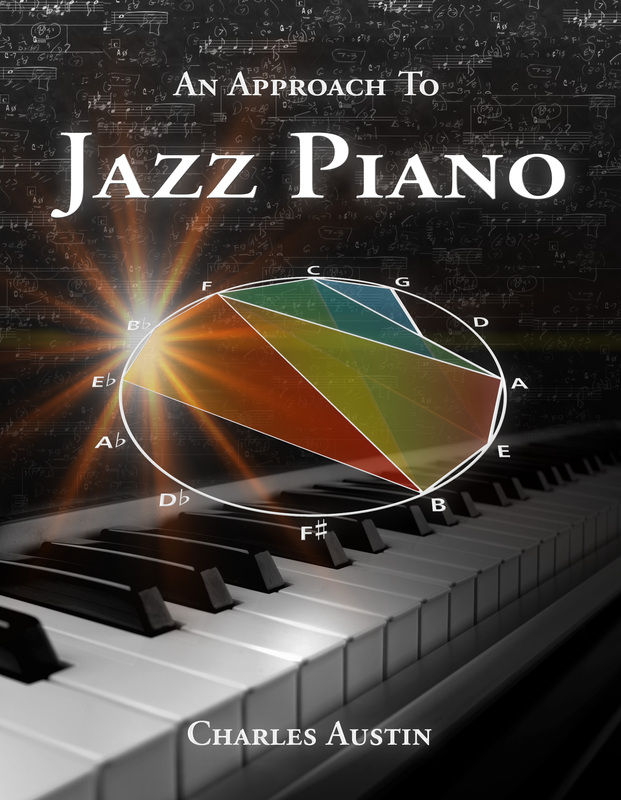An Approach to Jazz Piano
by Charles Austin, 456 pages, Fifth Edition
Available as coilbound paperback and PDF from Lulu, regular paperback from Amazon. Contents Overview
Topics explored in depth include triadic harmony in popular tune style, practical approaches to chord voicing, harmonic function, source scales & extensions, secondary dominants, modal borrowing, inside to outside scale choices, tritone substitution, the Blues, diminished seventh functions, polychords, slash-chords, the “Sound”, pentatonic voicings & source scales, pentatonic-shapes, altered pentatonics, Drop 2/3/2&4 voicings, passing chord harmony, quartal harmony, polarized passing-tone scales, diatonic/chromatic-approach tones, deflection, change-tones and numerous other melodic approaches to improvisation.
Table of ContentsRhythm Preface
1 The Keyboard: Interval Building Blocks 2 Intervals from the Major Scale: The First Source Scale 3 Inversions of Intervals 4 Compound Intervals 5 Key Signatures Outlined 6 Simple and Compound Intervals in Major Keys 7 The Solfege System and Directional Tendencies of Scale Tones 8 Common Intervalic Sequences 9 The Remaining Source Scales/Sequences 10 Intervals in Sequence: A Matrix 11 Triads 12 Open Voiced Triads 13 Triadic Harmony in Popular Tune Style 14 Voicing Melody in the Right Hand 15 7th Chords 16 Chord Voicing Part I: An Integrated Left Hand 7th Chord Voicing Approach — A Stride and Shell Technique 17 Harmonic Function Part I: Tonic, Dominant, and Subdominant 18 The Major Scale, Modes, Scale-Tone 7th Chords and Basic Improvisation 19 Improvising on Chord Changes: Phrasing and Guide Tones 20 Chord Qualities/Extensions in Chord Symbols and 7th-Chord-Tone Extension-Substitution Voicing Solutions 21 Chord Voicing Part II: An Integrated Left Hand Chord Voicing Approach -- Guide Tones and Extensions 22 Source Scales and Scale-Tone Intervals 23 Source Scale Construction and Tetrachords 24 Source Scales and Scale Tone Chords, Part I: Diatonic Scales 25 Source Scales and Scale Tone Chords, Part II: The Symmetrical Scales — The Diminished and Whole-Tone Scales 26 Scale/Chord Source-Scale Overview 27 Secondary Dominants: Conserving the Sense of Key 28 Secondary Dominants: Function, Source Scales, Modal Borrowing and Associated Keys 29 Secondary Dominants and the Emergence of Dominant Substitution: Tritone Substitution and Sub. V7 30 Secondary Dominants and Improvisation 31 Secondary Dominants and Related ii Chord/Scales: Conserving the Key 32 Secondary Dominants and Inside to Outside Scale Choices 33 SubV7 (Tritone—SubV7), Secondary SubV7, and Related II 34 Harmonic Function Part II: bVIIMa7 Subdominant, Subdominant Minor, and Modal Borrowing (part II) 35 Harmonic Function Part III:Tonic Minor Chord/Scales and Minor ii—V 36 Harmonic Function Part IV: Diminished 7th Chord Function: A Justification of Dominant 7th Chord Motion 37 Related Dominants, Related ii—V’s and Chord shapes from a Symmetrical Diminished Chord/Scale 38 The Blues Part 1: Form, Blues Scales, and Improvisation 39 The Blues Part II: A Vehicle for Progressive Harmonic Change 40 Chord Families/Chord Function Versus Chord Function/Chord Families: a Cross-Reference Review 41 Chord Voicing Part III: Two Hands 42 Pluralities In Extended Chords: Polychords, the Identification of Chord Stacks Between the Hands 43 Slash-Chords: Chord Forms over Bass Notes, Creating Chord Quality 44 The “Sound”: A Slash-chord Approach to Jazz Piano Voicing 45 Pentatonic Scale/Chords: Voicings, Pentatonic-shapes, Altered Pentatonics, Source Scales, and Function 46 Open 7th-Chord Voicings: Drop 2, Drop 3, Drop 2 & 4 And Use As Passing Chord Harmony 47 Comping: Articulation, Time Feels, Voicing-Style-Approach, And Form 48 The Thickening of a Melody Line: Locked-Hands, Slash-Chord, Drop 2, Pentatonics, Quartal Harmony 49 Scales with an Added Chromatic Passing Tone 50 Polarized Passing-Tone Scales and Improvisation 51 Neighbour Tones in Jazz: Diatonic/Chromatic-Approach Tones, Deflection, Change-Tones |
An Approach to Jazz Piano
An Approach to Jazz Piano is a comprehensive approach for serious students of jazz piano. In this clearly written instructional text, Charles Austin draws on a lifetime of experience as a professional jazz pianist and thirty as a college instructor guiding hundreds of students in the fundamentals of jazz piano. Interspersed throughout with exercises and practice suggestions, the book is a complete guide to learning jazz piano and a comprehensive resource for professionals.
Readers Say...“I would recommend An Approach to Jazz Piano to any jazz student as a 'must have' on your book shelf. I have referred to this very thorough and inclusive book many times over the years. One of the best piano instruction books out there.”
Read full review here
|




